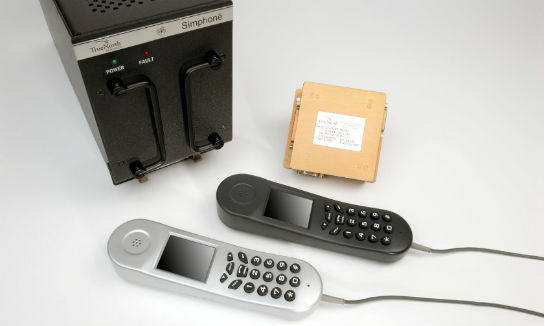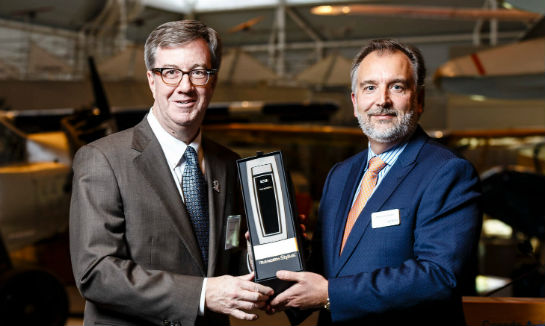An ancient Roman treatise on the planning and design of structures, De Architectura, holds that they should exhibit solidity, utility and beauty.
The concept is often taken as evidence of good design and engineering. Done well, the result is as much artistic as industrial. That’s arguably the case at TrueNorth Avionics Inc., a small Ottawa company with a high-end global presence in an exponentially-connected world.
When Skies broached the “form follows function” concept in an interview with TrueNorth founder and chief executive officer, Mark van Berkel replied that “we try hard to make our products look good as well as being fundamentally functional.” He and his team had just celebrated their 10th anniversary at the Canada Aviation and Space Museum. Surrounded by vintage aircraft, van Berkel—a self-described “techie”—said the pioneers who had flown them “really did change the world.”
TrueNorth continues to change it—notably the stratum occupied by business leaders, heads of state and others who require 24/7 connectivity. Mindful of the clients’ preference for privacy, van Berkel said his company’s bespoke handsets and underlying technologies are trusted for inflight communications by many Fortune 100 companies.
TrueNorth developed aviation’s first fully-customizable modular app-based cabin system, called Symphonē Chorus, followed by its Stylus and Stylus Wi-Fi phones. Now, with Canadian, U.S. and European certifications, TrueNorth is supporting larger manufacturers’ connected aircraft strategies.
A year after TrueNorth launched in 2006, its first installation was in a Bombardier Global Express; now, its technologies are being installed on most Boeing and Airbus business jet platforms and some from Gulfstream and Dassault. TrueNorth Avionics Photo
“The only business jets worth talking about will have a TrueNorth-enabled piece of technology on board,” van Berkel predicted. Its systems also are aboard the Canadian government’s executive fleet as well as the U.S. Air Force “blue and white” fleet used to fly legislators and senior administration and military staff.
Van Berkel didn’t set out to be a sales-oriented businessman. The former chief avionics specialist for Transport Canada’s Aircraft Services recalled being “offended” when a large manufacturer evidently saw something in him he wasn’t aware of. “I found that I liked dealing with customers” and he eventually nearly wound up running that company as other technical staff left.
“I evidently had a talent for seeing what was missing in the marketplace,” he told Skies. “Success in business parallels success in flying in that each requires good planning and decision-making—and preparedness for the unexpected.”
With a Southern Alberta Institute of Technology avionics engineering diploma, van Berkel initially was head-hunted by major companies. Instead, always having wanted to fly, he opted for a small Vancouver operation which, in addition to avionics work, afforded him access to its Cessna 172.
TrueNorth developed aviation’s first fully-customizable modular app-based cabin system, called Symphonē Chorus, followed by its Stylus and Stylus Wi-Fi phones. Mark van Berkel and Ottawa mayor Jim Watson are shown here displaying the TrueNorth Stylus. TrueNorth Avionics Photo
He has since logged nearly 1,000 hours, but business takes precedence. From that modest start, he eventually moved to the aforementioned manufacturer, where customers had expressed interest in having special handsets aboard their aircraft. When his employer said it preferred conventional “desk phones,” van Berkel left in 2004 to create TrueNorth with three partners.
Except for intellectual capital, van Berkel said the company “literally started from nothing,” but it has been profitable from the outset. Nowadays, its handsome handsets, which are available in a range of finishes, are the most obvious result of steady design evolution. They are the “form” while the “function” rests in a supporting array of sophisticated electronics.
Take the Optelity Hot Spot, for example. Unveiled last September, the product gives owners of smaller aircraft capabilities previously reserved for large long-range jets. Billed as “aviation’s smallest, lightest, fastest wireless access point,” the palm-size unit lets pilots use their electronic flight bags and passengers their smartphones, tablets and other Wi-Fi devices by simply linking up with an aircraft’s satellite broadband system.
Two months later, TrueNorth received a supplemental type certificate for its Optelity Cabin Gateway Pro, which offers an integrated suite of everything the connected operator could want, in a 3.3-kilogram package.
Developed and certified on a Gulfstream V, and supported by the Optelity Care program, the Gateway Pro was completed by Mid-Canada Mod Center in Toronto.
Most recently, the company introduced the industry’s first hybrid cloud connectivity solution, connected.aero. It works in conjunction with Optelity Pro to enhance bandwidth on an aircraft. TrueNorth Avionics Photo
It hasn’t always been smooth flying. The last global economic meltdown presented challenges, but van Berkel—who is now the majority shareholder—said, “This year, the company is well above our forecasts for sales and profitability.”
With approximately three dozen employees, TrueNorth wants to double its space and hire more staff. But finding software engineers can be particularly problematic in that more than 1,400 other similar-sized Ottawa companies are also on the hunt.
“If I were to forecast this time next year, we’d probably have 50 people,” said van Berkel. “We hang on to good ones.”





